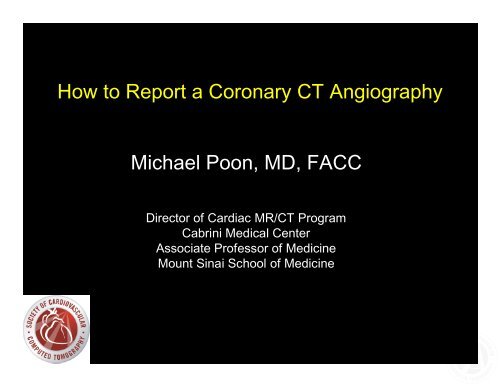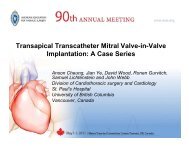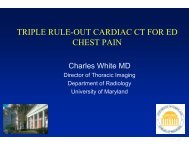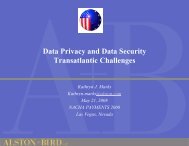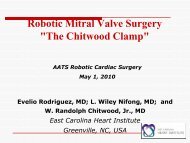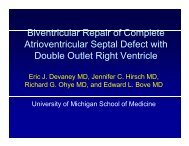How to Report a Coronary CT Angiography Michael Poon, MD, FACC
How to Report a Coronary CT Angiography Michael Poon, MD, FACC
How to Report a Coronary CT Angiography Michael Poon, MD, FACC
- No tags were found...
Create successful ePaper yourself
Turn your PDF publications into a flip-book with our unique Google optimized e-Paper software.
<strong>How</strong> <strong>to</strong> <strong>Report</strong> a <strong>Coronary</strong> <strong>CT</strong> <strong>Angiography</strong><strong>Michael</strong> <strong>Poon</strong>, <strong>MD</strong>, <strong>FACC</strong>Direc<strong>to</strong>r of Cardiac MR/<strong>CT</strong> ProgramCabrini Medical CenterAssociate Professor of MedicineMount Sinai School of Medicine
DISCLOSURE STATEMENT<strong>Michael</strong> <strong>Poon</strong>, <strong>MD</strong> has disclosed the information listed below. Anyreal or apparent conflict of interest related <strong>to</strong> the content of thepresentation has been resolved.Affiliation/Financial InterestGrant Support & ConsultantConsultantConsultantConsultantConsultantOrganizationSiemens Medical SolutionsTeraRecon Inc.Bracco Diagnostic Inc.Vital ImagesChase Medical Inc.
DukeACC Think Tank Meeting (2006)on“Dimensions of Cardiovacular Imaging Quality”“Better reporting translates in<strong>to</strong> betteroverall quality of care”Dr. Ray Gibbons, President of the AHA (20067)
Documentation Requirements(CMS)• Each claim must be submitted with ICD9CM codesthat reflect the condition of the patient, and indicate thereason(s) for which the service was performed. Claimssubmitted without ICD9CM codes will be returned.• The documentation of the study requires a formalwritten report, with clear identifying demographics, thename of the interpreting provider, the reason for thetests, an interpretive report and copies of images. Thecomputerized data with image reconstruction shouldalso be maintained.• Documentation must be available <strong>to</strong> Medicare uponrequest
Optimal <strong>Report</strong> Generation•Indication•Clinical His<strong>to</strong>ry•Procedure•Findings•Impression
Optimal <strong>Report</strong> Generation•Indication•Clinical His<strong>to</strong>ry•Procedure•Findings•Impression
New Category III CPT Codes for <strong>Coronary</strong><strong>CT</strong>A• 0144T <strong>CT</strong>, heart, without contrast material, including image postprocessing & quantitativeevaluation of coronary calcium• 0145T <strong>CT</strong> heart, without contrast material followed by contrast material(s) & further sections,including cardiac gating and 3D image postprocessing; cardiac structure & morphology• 0146T <strong>CT</strong> angiography of coronary arteries (C<strong>CT</strong>A) (including native & anomalous coronaryarteries, coronary bypass grafts), without quantitative evaluation of coronary calcium• 0147T C<strong>CT</strong>A with quantitative evaluation of coronary calcium• 0148T Cardiac structure & morphology and C<strong>CT</strong>A, without quantitative evaluation of coronarycalcium• 0149T Cardiac structure & morphology and C<strong>CT</strong>A, with quantitative evaluation of coronary calcium• 0150T Cardiac structure and morphology in congenital heart disease• 0151T <strong>CT</strong>, heart, without contrast material followed by contrast material(s) & further sections,including cardiac gating and 3D image postprocessing; function evaluation (L & R ventricularfunction, ejection fraction, & segmental wall motion)(effective Jan 1, 2006)
New Category III CPT Codes for <strong>Coronary</strong><strong>CT</strong>A• 0145T <strong>CT</strong> heart, without contrast material followed by contrast material(s) & further sections,including cardiac gating and 3D image postprocessing; cardiac structure & morphology• 0146T <strong>CT</strong> angiography of coronary arteries (C<strong>CT</strong>A) (including native & anomalous coronaryarteries, coronary bypass grafts), without quantitative evaluation of coronary calcium• 0148T Cardiac structure & morphology and C<strong>CT</strong>A, without quantitative evaluation of coronarycalcium• 0150T Cardiac structure and morphology in congenital heart disease• +0151T <strong>CT</strong>, heart, without contrast material followed by contrast material(s) & further sections,including cardiac gating and 3D image postprocessing; function evaluation (L & R ventricularfunction, ejection fraction, & segmental wall motion)(effective Jan 1, 2006)
Indications•Model LCD(WWW.SC<strong>CT</strong>.ORG/ADVOCACY/INDEX.CFM•Appropriateness Criteria(www.acc.org/qualityandscience/clinical/<strong>to</strong>pic/<strong>to</strong>pic.htm)
Indications•Model LCD(WWW.SC<strong>CT</strong>.ORG/ADVOCACY/INDEX.CFM•Appropriateness Criteria(www.acc.org/qualityandscience/clinical/<strong>to</strong>pic/<strong>to</strong>pic.htm)
<strong>Report</strong> generation•1. Indication = ICD9 code(s)Model LCD
ICD9CM
Optimal <strong>Report</strong> Generation•Indication•Clinical His<strong>to</strong>ry•Procedure•Findings•Impression
Model Local Coverage Determination (LCD)Indications 1 10• 1. <strong>Coronary</strong> <strong>CT</strong>A used as a first test <strong>to</strong> assessthe cause of chest pain.• 2. <strong>Coronary</strong> <strong>CT</strong>A used as a triage <strong>to</strong>ol <strong>to</strong>invasive coronary angiography following a stresstest that is equivocal or suspected <strong>to</strong> beinaccurate.• 3 <strong>Coronary</strong> <strong>CT</strong>A <strong>to</strong> evaluate the cause ofsymp<strong>to</strong>ms in patients with known coronary arterydisease.
Model LCD• 4. <strong>Coronary</strong> <strong>CT</strong>A <strong>to</strong> evaluate the cause of chestpain or dyspnea in patients with prior bypasssurgery or intracoronary artery stent placement*.• 5. <strong>Coronary</strong> <strong>CT</strong>A for suspected congenitalanomalies of the coronary circulation.• 6. <strong>Coronary</strong> <strong>CT</strong>A for evaluation of acute chestpain in the emergency room*.* New indications since LCD on 71275
Model LCD•7. <strong>CT</strong>A for the assessment of coronary orpulmonary venous ana<strong>to</strong>my• 8. Use of coronary <strong>CT</strong>A prior <strong>to</strong> noncoronaryartery cardiac surgery.* New indications since LCD on 71275
Model LCD9. Quantitative evaluation of coronary calcium <strong>to</strong> beused as a triage <strong>to</strong>ol in patients with typical chestpain and unknown Agats<strong>to</strong>n score <strong>to</strong> determineappropriateness of coronary <strong>CT</strong>A vs. cathetercoronary angiography*.10. Quantitative evaluation of coronary calcium <strong>to</strong> beused as a triage <strong>to</strong>ol for lipidlowering therapy inpatients with moderate <strong>to</strong> high Framingham Riskscore*.* New indications since LCD on 71275
Appropriateness Indications1. Evaluation of chest pain syndrome in patients with intermediate pretestprobability of CAD.2. Evaluation of acute chest pain in patients with intermediate pretestprobability of CAD.3. Evaluation of suspected coronary anomalies4. Evaluation of chest pain syndrome in patients with uninterpretable orequivocal stress test.5. Assessment of complex congenital heart disease including anomalies ofcoronaries, great vessels, and cardiac chambers and valves.6. Evaluation of coronary arteries in patients with new onset heart failure <strong>to</strong>assess etiology.7. Evaluation of cardiac mass8. Evaluation of pericardial conditions9. Evaluation of pulmonary vein ana<strong>to</strong>my prior <strong>to</strong> invasive radio frequencyablation for atrial fibrillation.10. Noninvasive coronary vein mapping prior <strong>to</strong> placement of biventricularpacemaker11. Noninvasive coronary arterial mapping, including internal mammary artery,prior <strong>to</strong> repeat cardiac surgical revascularization.12. Evaluation of suspected aortic dissection or thoracic aortic aneurysm.13. Evaluation of suspected pulmonary embolism.
C<strong>CT</strong> Coverage• As of December 1, 2006 all Medicare Carriershad coverage policies/articles in place forC<strong>CT</strong>A• Major health plans are following the trend• CIGNA• Aetna, effective July 1, 2007• UHC/Oxford• More than 8 BCBS Plans with coverage• WellPoint and BCBSFL with limited coverage1Indication (i.e. evaluation of congenital coronaryanomalies following unsuccessful invasive angiography)
Optimal <strong>Report</strong> Generation•Indication•Clinical His<strong>to</strong>ry•Procedure•Findings•Impression
Procedure<strong>CT</strong> <strong>Angiography</strong> of the coronaries with and without contrast was performedusing a 16/32/40/64/128/256detec<strong>to</strong>r <strong>CT</strong> scanner. Axial images were obtainedfrom the level of the subclavian artery/aortic arch/ascending aorta through <strong>to</strong>the diaphragm at 0.6 collimation mm section thickness during breath hold withor without ECGgated current modulation. 65 110 ml of intravenous contrastwas injected via a right/left antecubital intravenous catheter at 47 ml/sec with50 ml of (dual flow (30C/70S) or 50 ml of saline saline) infused immediatelyafterward. Image reconstructions were performed at 0.6 mm thickness/0.4interval mm using retrospective cardiac gating. 3D and multiplanarreconstructions were performed. 040 mg of Lopressor (+/ additional calciumchannel blocker) was given intravenously and the heart rate at the time ofimage acquisition was approximately 65 bpm. One dose of 0.4 mgsublingual/sublingual nitroglycerin was given ~5 min prior <strong>to</strong> the <strong>CT</strong>A. Theheart rhythm was regular/irregular with/without frequent atrial orventricular premature beats.
ProcedureOverall Quality of the study:Excellent: no artifactsGood: minor artifact but good diagnostic qualityAcceptable: Moderate artifacts but adequate diagnostic qualityPoor/Suboptimal: Severe artifacts and not readableSuboptimal due <strong>to</strong>:a. Motion: cardiac (tachycardial or bradycardia), irregular heart rhythm,respira<strong>to</strong>ry, voluntary or involuntary body motion.b. Poor overall contrast enhancement: poor timing of the contrastarrival, large body habitus.c. Metallic implants (sternal wires, pacemaker or defribrilla<strong>to</strong>r wires,surgical clips, or tissue expander)d. Calcium
Respira<strong>to</strong>ry Artifacts
High Heart Rate: Double Images Artifacts
Metal Artifacts
Category III CPT Codes for <strong>Coronary</strong> <strong>CT</strong>A• 0146T Computed Tomography angiography ofcoronary arteries (including native andanomalous coronary arteries, coronary bypassgrafts), without quantitative evaluation ofcoronary calcium• 0147T Computed Tomography angiography ofcoronary arteries (including native andanomalous coronary arteries, coronary bypassgrafts), with quantitative evaluation of coronarycalcium(effective Jan 1, 2006)
Optimal <strong>Report</strong> Generation•Indication•Clinical His<strong>to</strong>ry•Procedure•Findings•Impression
Calcium Score011011100101400Over 400InterpretationNo identifiable atherosclerotic plaque.Very low cardiovascular disease risk.Less than 5% chance of presence ofcoronary artery disease.A Negative Examination.Minimal plaque burden.Significant coronary artery disease veryunlikely.Mild plaque burden.Likely mild or minimal coronarystenosis.Moderate plaque burden.Moderate nonobstructive coronaryartery disease highly likely.Extensive plaque burden.High likelihood of at least onesignificant coronary stenosis (>50%diameter).
New Category III CPT Codes for <strong>Coronary</strong><strong>CT</strong>A• 0146T Computed Tomography angiography ofcoronary arteries (including native andanomalous coronary arteries, coronary bypassgrafts), without quantitative evaluation ofcoronary calcium• 0147T Computed Tomography angiography ofcoronary arteries (including native andanomalous coronary arteries, coronary bypassgrafts), with quantitative evaluation of coronarycalcium(effective Jan 1, 2006)
Subjective Evaluation using MPRThere is a mixed nonobstructive(50%) noncalcified plaque andis a bifurcating vessel. Mid LADhas small nonobstructive mixedplaques. Distal LAD is normal.
Quantitative Analysis Using CMPR
Sample <strong>Report</strong> for 0146T
Final Impression:1. Normal Study2. Mild Disease (
Cardiac Incidental FindingsControversial Topic: Many Radiologists prefer Cardiologyinput.
Anomalous <strong>Coronary</strong> ArteryCurved MPR View of the Left Main from RCA3DVRT View of the RCA from the Left Main<strong>Poon</strong> M, Nat Clin Pract Cardiovasc Med. 2006 May;3(5):26575. Review
DOT Sign
The Prevalence of Anomalous Origin of <strong>Coronary</strong> Artery: A MultiCenter Study†Zeng Y, ‡Mendelsohn SL, Karimjee N, ‡Day R, †<strong>Poon</strong> M†Cabrini Medical Center, New York, NY, ‡ZwangerPesiri Radiology, E. Setauket, NY, Life Imaging, Huntsville, TXBACKGROUNDRESULTSRESULTS<strong>Report</strong>ed incidence of coronary artery anomalies varybetween 0.4% and 0.8% in angiographic studies and 0.3% inan au<strong>to</strong>psy series. <strong>MD</strong><strong>CT</strong> is evolving rapidly as a noninvasiveimaging method of choice for the evaluation of coronaryanomaly; however the frequency of such finding has not beenreported in <strong>MD</strong><strong>CT</strong> studies. We aimed <strong>to</strong> investigate theprevalence of anomalous origin of coronary artery in threediagnostic imaging centers.LM from right sinus between AOand LALM from right sinus between AOand PALCX from right sinusRCA from left sinus0.06%0.03%0.32%0.23%LMI29%RCA1150%LMII15%LCX836%Left circumflex (LCX) coronary artery from right coronary sinusTotal0.64%METHODSA retrospective chart review of a 3356 patient registry fromthree diagnostic imaging centers in the United States (2 fromNew York and one from Texas). 2007 patients from CabriniMedical Center, NY; 584 from Life Imagine, Texas; and 765patients from ZwangerPesiri Radiology groups, New York.All patients were referred for the evaluation of suspected orknown coronary artery disease on a 16, 64, or 128slice<strong>MD</strong><strong>CT</strong> scanner.Left main (LM) coronary artery from right coronary sinus Anomalous LM courses between ascending aorta and pulmonary arteryRight coronary (RCA) artery from right coronary sinusRESULTS22 patients (0.66%) with anomalous origin of coronary arteryincluding: anomalous origin of the left circumflex coronaryartery from right coronary sinus which courses anteriorlybetween ascending aorta and left atrium (n=11, 0.32%);anomalous origin of right coronary artery from left coronarysinus which travels posteriorly between the ascending aortaand right ventricular outflow tract (n=8, 0.23%); anomalousorigin of left main coronary artery from right coronary sinuswhich courses anteriorly between ascending aorta and leftatrium (n=2, 0.06%) or courses between ascending aorta andpulmonary artery (n=1, 0.03%). Anomalous LM courses between ascending aorta and left atriumCONCLUSIONSAdult anomalous origins of coronary artery are not verycommon and are usually incidental findings of diagnosticcatheterization or <strong>MD</strong><strong>CT</strong> studies. Among the various anomaliesof the origin, left circumflex coronary artery anomalies are themost frequent (50 %), followed by the right coronary artery (36%) and the left main coronary artery (14%). Anomalous originof coronary artery that courses between the great vessels isassociated with the risks of syncope, myocardial ischemia andsudden death. <strong>MD</strong><strong>CT</strong> may emerge as the imaging modality ofchoice for the evaluation of such coronary anomaly.
Kawasaki’s Disease
AV FistulaConus br <strong>to</strong> Anterior Cardiac VeinLM <strong>to</strong> PA
Giant <strong>Coronary</strong> Aneurysm
ASD
Double Chambered LVSanz J, Rius T, Kuschnir P, Macalusa F, Fuster V, <strong>Poon</strong> M. Circulation 2004
NonCardiac Incidental FindingsControversial Topic: Majority of Cardiologists prefer Radiology Overread.
The Prevalence and Significance of Incidental FindingsDuring Cardiac 64 or 128 Slice Computed TomographyDinh H*, Stecko J†, Mendelsohn S‡, Day B‡, <strong>Poon</strong> M†.*David Geffen School of Medicine at UCLA, Los Angeles CA, USA. †Cabrini Medical Center, New York, NY, USA. ‡ZwangerPesiri Radiology,BACKGROUND•The number of outpatient private practicefacilities offering multirow detec<strong>to</strong>r computed<strong>to</strong>mography (<strong>MD</strong><strong>CT</strong>) is on the rise.•Noncardiac pathology may be imaged andmissed if not routinely assessed by theinterpreting physician.•Few studies have looked at the prevalence ofextracardiac incidental findings at outpatientfacilities.PURPOSE AND HYPOTHESISWe investigated the frequency and significance ofincidental findings during cardiac <strong>MD</strong><strong>CT</strong>.MATERIALS AND METHODSA <strong>to</strong>tal of 512 consecutive patients underwent 64or 128slice <strong>MD</strong><strong>CT</strong> (440 and 72, respectively)between the period of September 2005 <strong>to</strong> March2007 at two outpatient private practices.Radiology and cardiology final reports werereviewed for incidental findings, which weredefined as noncardiac diagnoses not previouslyknown. Findings of clinical significance weredefined as those requiring follow up diagnosticimaging or intervention.RESULTSA <strong>to</strong>tal of 575 new, extracardiac findings wereidentified. Of this, 187 (33%) were clinicallysignificant. Per patient analysis showed that 117(23%) of patients had at least one new clinicallysignificant finding. The prevalence of allincidental findings, significant clinical findings,and specific significant incidental findings aresummarized in the table below.N = 511PulmonaryVascularHepaticGastrointestinalThyroidAdrenalOrthopedicOtherIncidentalFindings(No.Patients,%)189 (37%)105 (21%)61 (12%)41 (8%)25 (5%)22 (4%)9 (2%)47 (9%)E. Setauket, NY, USA.ClinicallySignificantIncidentalFindings(No.Patients,%)48 (9%)15 (3%)3 (0.6%)3 (0.4%)25 (5%)21 (4%)1 (0.2%)4 (0.8%)Clinically Significant Diagnoses(No. lesions)•Nodule/granuloma (>1cm) 83•Cavitated granuloma 1•Mass (1cm) 14•Metastatic cancer 1•Pulmonary embolus 1•Ascending aorta aneurysm 8•Descending aorta aneurysm 3•Aortic arch aneurysm 1•Type B dissection 1•Splenic artery aneurysm (>1.5 cm) 3•Celiac artery aneurysm (>1.5 cm) 3•Mass 3.5 cm 1•Lesions (not cysts) 2•Hiatal hernia (entire s<strong>to</strong>mach inthorax) 1•Mesenteric lymph node >1.5 cm 1•Pancreatic necrosis/fat/atrophy 2•Thyromegaly 3•Lesion/mass/nodule 22•Adenoma (>1cm) 19•Nodule (>1cm) 1•Myelolipoma 1•Sclerosis vertebral body/mets 1•Angiomyolipoma 1•Breast calcification 1•Breast soft density 1•Axillary lymph node 1EXAMPLES OF INCIDENTAL FINDINGSCONCLUSIONSOutpatient private practice per patient prevalence ofclinically significant noncardiac incidental findings isabout 23% during coronary <strong>MD</strong><strong>CT</strong> examinations which issimilar <strong>to</strong> published data at academic centers and inpatientsettings. Review of all imaging data is important <strong>to</strong> avoidmissing potentially treatable disease.
SC<strong>CT</strong> Action ItemQuality Task Force: Dr. W. Guy WeigoldCardiac <strong>CT</strong> Data Elements and Standardized<strong>Report</strong>ing: Dr. Gil Raff
WWW.SC<strong>CT</strong>.ORG
New Category III CPT Codes for <strong>Coronary</strong><strong>CT</strong>A•+0151T Computed <strong>to</strong>mography, heart,without contrast material followed bycontrast material(s) and furthersections, including cardiac gating and3D image post processing; functionevaluation (left and right ventricularfunction, ejection fraction andsegmental wall motion)(effective Jan 1, 2006)
<strong>CT</strong> Evaluation of Cardiac FunctionASSESSMENT OF LEFT AND RIGHT VENTRICULAR FUN<strong>CT</strong>ION WITH MULTIDETE<strong>CT</strong>OR ROW COMPUTED TOMOGRAPHY(<strong>MD</strong><strong>CT</strong>): COMPARISON WITH CARDIAC MAGNETIC RESONANCE (CMR)Teresa Rius, M.D., Javier Sanz, M.D., Paola Kuschnir, M.D. , Rafael Salguero, M.D. , Roman Fiscbach, M.D. , Bernd Ohnesorge,Ph.D., Valentin Fuster, M.D., Ph.D. , <strong>Michael</strong> <strong>Poon</strong>, M.D. 2006
<strong>CT</strong> function: Left VentricleA B CSimultaneous and au<strong>to</strong>matic displays of 3 multiplanarreconstructions of the left ventricle in endsys<strong>to</strong>le generated by thecardiac volume analysis softwareFigure A: Longaxis four chamber view of LVESV.Figure B: Longaxis two chamber view of LVESVFigure C: Short axis view of LVESV
<strong>CT</strong> function: Right VentricleA B CSimultaneous and au<strong>to</strong>matic displays of 3 multiplanar reconstructions of the rightventricle in endsys<strong>to</strong>le generated by the cardiac volume analysis softwareFigure A: Longaxis four chamber view of RVESV.Figure B: Longaxis two chamber view of RVESVFigure C: Short axis view of RVESV
0151T: Normal Values (CMR)Eike Nagel, Myocardial Function and Stress Imaging in Cardiovascular Magnetic Resonance, Martin Dunitz 2003
0151T: Normal Values (CMR)Eike Nagel, Myocardial Function and Stress Imaging in Cardiovascular Magnetic Resonance, Martin Dunitz 2003


